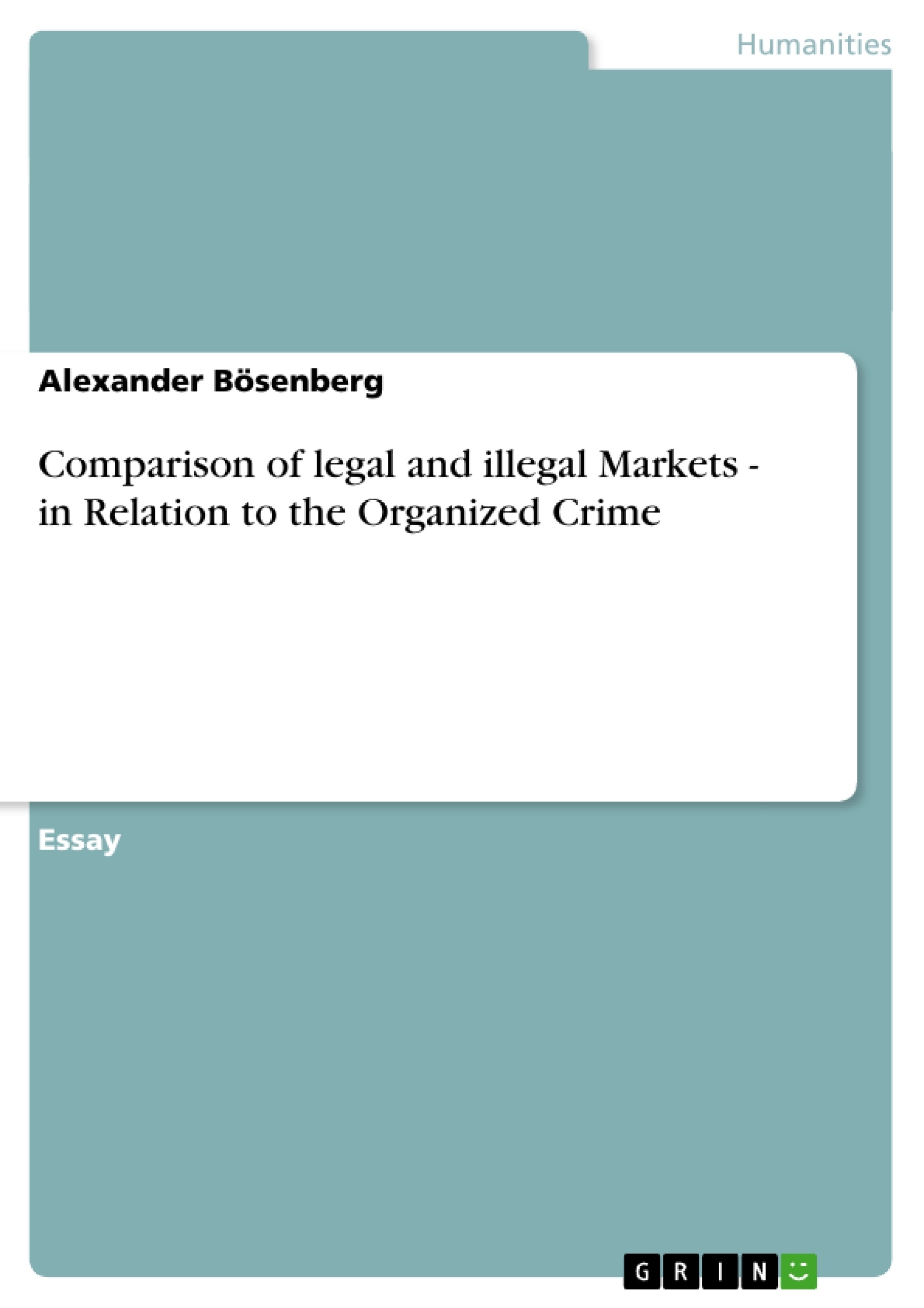Excerpt
Table of content
1. Introduction
2. The Legal and Illegal Market in Scope
3. Differences between Markets, their Entrepreneurs and the Influence of Organized Crime in Economy
4. Perspective-the modern Illegal Economy System Camorra
5. References
1. Introduction
Cigarettes smuggling, gambling, prostitution, waste disposal, extortion, tax dodging and drug selling sounds like typically characteristics for organized crime like the Sicilian Mafia. It’s clear, that these “branches” fall automatically into the hands of organized crime because they have nothing to do with legality and fair-play in modern state. But it’s also clear, that illegal markets exist and that they work very efficient and profitable. For example the worldwide drug traffic achieved a various volume of ca. 600 to l000 billion US $ each year (Schneider, 2006). That’s more money used for drugs than for public research in the United States. So we can assume that illegal markets have a basis in supply and demand and they are important and present in every economy.
On the other side there is a general liability to pure capitalism in every economy – legal and illegal. This mean, that entrepreneurs are stronger confronted by business competition, changing politics and locations, the phenomenon of globalization and fast changing trade conditions everywhere. The main target is still the same: having low costs as possible and a maximum of profit to survive.
This paper wants to show the different terms and methods of legal and illegal markets and their entrepreneurs especially the organized crime. It also shows that legal and illegal activities particularly overlap. For example illegal capital can be reinvested into legal business but also legal business can cooperate with illegal activities. I think about tax dodging, corruption, monopolizing and also the use of violence, money laundering and multi-million bribes to take the economical lead. The purpose is to consider facts, empirical findings and coherences from relevant literature to give a problematic overview and to affirm that illegal markets are a part of the every economy. In advance it’s still to be clarified what makes the difference between legal and illegal markets and we have to find out what similarities they have. Moreover we will ask how different these actors of both markets are and what different methods they use.
Primary the paper analyzes the structure of legal and illegal markets. The focus is set to the organization, the participators and influencing factors of these markets. After that I will work out differences and similarities to compare them. The results will be outlined and afterwards discussed by focusing the modern organized crime. It’s my concern to show that illegal markets are omnipresent in economy welfare and that organized crime diffuses them into legal markets. The paper closes with an example of the Camorra Syndicate and gives a perspective of modern illegal business in a critical out view.
2. The Legal and Illegal Market in Scope
The (legal) market in common
In the broadest sense a market is described as a gathering place for people’s supply and demand. Therefore a market offer and request different goods and services and define a price. The suppliers wanted to sell their goods and services with a high profit as possible. But they have to accept basic economy rules. The quantity of a good grows if also the price is growing. If the suppliers expect a lower price for their goods they will also reduce its quantity. Here every supplier wanted the highest profit and so they have a strong competition on the markets. They have the option to produce more efficient and with lower costs as their competition. That’s the business competition.
On the other side there are the customers. They want satisfy their individual needs and that’s for a preferable price. If the price is low they will buy a higher quantity of that good, is the price growing they will buy less of the good. In the model of the ideal market exists one good with a determinate quality, open competition, full transparency, fully access to the market, no external effects, endless resources and constant customer preferences. Supply and demand stand in balance and hold the market profitable by the price. According to that the market fulfils the important function to inform suppliers and customers, coordinate quality and quantity of supplied and requested goods and services and find out the best price for it (Bauer and Hogen, 2004, p. 75). It’s the basic for every economy and welfare state.
To keep a market working it’s important to have rules and norms for their users. The trade on a market depends on institutions which define the character of these markets. In an economy various decisions and interactions are coordinated by rules of these markets. It matters that insecure prices, competition business, lack of information’s and missing reputation – so called transactions costs – are neutralized at most. That’s the job of the institutions to set market rules and make trade secure and fair for every one. State with its institutions is the factor of fundamental meaning. The function of the state is to hold up basic rules and laws like the prevention of violence and cheating, protection of ownership, protection of freedom of contract and the adherence of applicable law. Everybody joining a market have to be bound by these rules. Users can express their various individual possibilities, preferences, risks and interests in secure. Assurance of a market is as well furthered by typical contracts, standardized currency, advising services, guarantees, insurances, trademarks and so on (Schüller, l986 p. 34). In short these are the main functions to keep a (legal) market working and to reduce various transaction costs.
- Quote paper
- Alexander Bösenberg (Author), 2007, Comparison of legal and illegal Markets - in Relation to the Organized Crime, Munich, GRIN Verlag, https://www.grin.com/document/111451
Publish now - it's free






















Comments